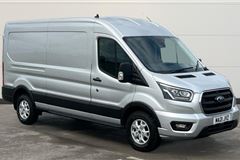Ford Transit (2006 – 2014) Review
Ford Transit (2006 – 2014) At A Glance
Backbone of Britain, best selling van for more than 40 years, a byword for light commercial vehicles. Call it what you like, the Ford Transit is the van by which all others are judged. Just when it looked like the competition was nipping at heels at the end of 2011, Ford pulled a blinder by launched the Euro 5-compliant model, which features a 2.2-litre turbodiesel in various power offerings that replaces all previous engine choices.
At a stroke, Ford put itself back at the head of the class and it also took the chance to address criticisms of in-cab noise. The Transit is now easily one of the most refined vans to drive and it also features a superb gear shift for its standard six-speed manual gearbox.
The rest of the Transit is much as it was when launched in 2006, which means rugged mechanical parts and strong reliability. There are also good deals to be had from Ford dealers.
All of this makes the Transit a very sound choice for any owner operator, but it gets better still when you know every Transit comes with ESP traction control as standard.
Then there’s the choice of front, rear and four-wheel drive, short and long wheelbases, different body lengths, various roof heights and a number of off-the-shelf body configurations from Ford. If there isn’t a Transit that suits you business’ needs, the chances are you either don’t need a van or should be buying a much heavier vehicle.
Driving the Ford Transit (2006 – 2014)
Ford updated the Transit at the tale end of 2011 and added Euro 5-compliant engines to the whole range. Every engine on offer is now a 2.2-litre turbodiesel and they come in 100PS, 125PS, 135PS, 140PS and 155PS guises. If you’re wondering why there is such a spread of engines, it’s because not every engine is offered with every version.
This is due to Ford offering the Transit with front, rear and all-wheel drive. The four-wheel drive model is only sold with the 125PS, 350Nm version of the 2.2-litre engine, which is the least common choice among Transit buyers. Much more common is the 125PS 2.2 TDCi that is offered in both front and rear-wheel drive models, alongside the 100PS low-power engine. For front-wheel drive Transits, there is also the choice of a 140PS engine, while rear-drive models can be had with a 135PS engine with either 355Nm or 385Nm of low-rev shove.
All of these various engine options come attached to a six-speed manual gearbox as standard. This transmission deserves special mention for the quality of its shift action. It may be a small detail, but when van drivers spend so much time and so many miles at the wheel it’s the details that count. The revised Transit’s gear shift is a pleasure to use and in fact puts many passenger cars’ gearboxes to shame.
It’s also worth mentioning the Transit now comes with engine stop/start, switching off the engine when the vehicle is at a standstill with the gearbox in neutral and the clutch disengaged. It helps saves fuel and could have a significant bearing on fuel costs for those who spend a lot of time in urban traffic conditions. Ford also now fits regenerative charging, so the battery is charged up as the van slows, saving otherwise wasted energy.
Ford’s ECOnetic technology has been expanded further across the Transit range with the new Euro 5 engine. You can now have a 280S short wheelbase front-drive model or 350L long wheelbase front-driver with this fuel-saving technology. It also helps lower carbon dioxide emissions, with the 280S emitting 173g/km and the 350L a respectable 189g/km.
All of this is welcome stuff, but at heart this Ford remains great to drive. The engines pull strongly and the popular 125PS front-drive model makes light work of heavy payloads. It deals with hills and steep inclines easily, rarely requiring a drop down from the higher gears to maintain momentum.
Comfort is another Ford Transit strong point thanks to supple suspension that deals with almost every type of lump and bump without fuss or distress. This is all the more impressive when you notice the Transit doesn’t display any untoward body lean in corners, even when laden, while the steering is direct and responsive yet light around town. It also has a tight turning circle at 10.8m in short wheelbase form to better the Fiat Ducato’s more than decent turning ability.
New for the revised Transit is a standard speed limiter set at 70mph. More unusual is the button on the dash to disable the limiter, which seems to defeat the purpose of having such a device in the first place if a driver can switch it off the moment he or she is out of sight of the depot.
But Ford has addressed the Transit’s noisy cabin. By carefully isolating every potential source of noise intrusion from the engine, as well as the road and wind at higher speeds, Ford has made the Transit’s cab easily the quietest and most refined of any its sector. It may seem like a small matter on first acquaintance, but the reduction in noise inside the Transit has a big impact over long days on driver fatigue, making it a more pleasant place to spend the working day.
Ford Transit (2006 – 2014) interior
As we’ve come to expect of the Transit, it offers almost limitless options to its buyers to suit every need. There are three wheelbases to choose from, three roof heights and four body lengths. Gross vehicle weights start at 2.5-tonnes and go all the way up to 4.6-tonnes, while payload maximums start at 772kg and carry on up to 1655kg depending on the model you choose.
The Transit can carry from 6.6m3 up to 14.3m3, again based on which version you buy. These figures are not quite as generous as a Fiat Ducato, which can carry more volume in its smallest and largest configurations. However, the Transit does compensate to some extent with the variety of body options available over the counter to customers. It can be bought as a panel van, minibus, side tipper, Luton van, and pick-up, as well chassis cab and double chassis cab. There are also crew cab versions on offer to make the Transit suitable for just about every user’s needs.
You can also specify heavy duty axles and suspension for more weighty needs and there is also a double rear wheel option for those who need the strongest possible vehicle. To get into the Transit’s load bay, there are side-hinged rear doors that open at up to 180-degrees on the standard models and as wide as 256-degrees on the Jumbo versions. A sliding rear side door is standard, with twin sliding rear doors an option. An optional Protection Kit provides MDF side panels and a full length rubber mat to keep the interior free from scrapes and scratches.
Plenty of securing hooks and lashing points help tie down loads, while Ford claims the distance between the rear wheelarches of the Transit is biggest in the class.
In the front cab, the Transit has supportive seats and a fine driving position that is more car-like than many vans. The gear lever is mounted high on the centre console and close to the steering wheel for stress-free shifts. There’s also plenty of storage boxes, cubbies and trays spread around the Transit’s cabin, though some of the interior plastics feel less durable than some rivals.
Still, the dials are easy to read and Ford will sell you its Premium Visibility Pack as an option that includes electrically heated door mirrors, automatic headlights and rain-sensing wipers. Better still, every Transit comes with Ford’s simple but effective Quickclear windscreen that does a great job of demisting or de-icing the windscreen in no time at all. A CD stereo with remote controls, electric windows, central locking and tinted glass are all standard on every model.
You can pick from Standard, ECOnetic, Trend, Limited and SportVan trims, and each comes with increased 20,000-mile service intervals, extending scheduled halts from the previous 15,000-mile mark.
Ford Transit (2006 – 2014) models and specs
| Dimensions | |
|---|---|
| Length | 3871–6717 mm |
| Width | 1795–2170 mm |
| Height | 1980–3118 mm |
| Load Volume | 4.2–17.1 m3 |
| Miscellaneous | |
|---|---|
| Kerb Weight | 1556–2761 kg |
| Payload | 759–2724 kg |
| Warranty | 36/100,000 |
| Servicing | 30,000/24 Months |
Chassis Cab
Chassis Cab LWB
| Version | List Price | MPG | |
|---|---|---|---|
| 350 LWB 2.4 TDCi 100PS | £22,555 | - | Details |
| 350 LWB 2.4 TDCi 115PS | £23,370 | - | Details |
| 350 LWB 2.4 TDCi 140PS | £24,370 | - | Details |
| 350 LWB HD 3.2 TDCi 200PS | £28,570 | - | Details |
Chassis Cab MWB
| Version | List Price | MPG | |
|---|---|---|---|
| 350 MWB 2.4 TDCi 100PS | £22,305 | - | Details |
| 350 MWB 2.4 TDCi 115PS | £23,120 | - | Details |
| 350 MWB 2.4 TDCi 140PS | £24,120 | - | Details |
| 350 MWB 3.2 TDCi 200PS | £26,620 | - | Details |
| 350 MWB HD 2.4 TDCi 140PS | £25,020 | - | Details |
| 460 MWB 2.4 TDCi 140PS | £25,770 | - | Details |
Chassis Cab SWB
| Version | List Price | MPG | |
|---|---|---|---|
| 300 SWB 2.2 TDCi 115PS | £17,730 | - | Details |
| 300 SWB 2.4 TDCi 100PS | £17,915 | - | Details |
Crew Cab LWB
| Version | List Price | MPG | |
|---|---|---|---|
| 350 LWB 3.2 TDCi 200PS | £27,670 | - | Details |
Curtainsider
| Version | List Price | MPG | |
|---|---|---|---|
| 350EF 2.4 TDCi 115PS | £31,270 | - | Details |
| 350EF 2.4 TDCi 140PS | £32,270 | - | Details |
| 460EF 2.4 TDCi 140PS | £34,545 | - | Details |
CurtainSlider
| Version | List Price | MPG | |
|---|---|---|---|
| 350 EF 2.2 TDCi 125 | £33,320 | - | Details |
| 350 EF 2.2 TDCi 155 | £34,320 | - | Details |
| 460 EF 2.2 TDCi 155 | £36,595 | - | Details |
Double Cab Dropside
| Version | List Price | MPG | |
|---|---|---|---|
| 350EF Double Cab 2.4 TDCi 140PS | £28,270 | - | Details |
| 350EF Double Cab 2.4 TDCi 100PS | £26,455 | - | Details |
| 350EF Double Cab 2.4 TDCi 115PS | £27,270 | - | Details |
| 350L Double Cab 2.4 TDCi 100PS | £26,105 | - | Details |
| 350L Double Cab 2.4 TDCi 115PS | £26,920 | - | Details |
| 350L Double Cab 2.4 TDCi 140PS | £27,920 | - | Details |
| Double Cab 350 EF 2.2 TDCi 100 | £28,505 | - | Details |
| Double Cab 350 EF 2.2 TDCi 125 | £29,320 | - | Details |
| Double Cab 350 EF 2.2 TDCi 155 | £30,320 | - | Details |
Double Cab Dropside LWB
| Version | List Price | MPG | |
|---|---|---|---|
| Double Cab 350 LWB 2.2 TDCi 100 | £28,155 | - | Details |
| Double Cab 350 LWB 2.2 TDCi 125 | £28,970 | - | Details |
| Double Cab 350 LWB 2.2 TDCi 155 | £29,970 | - | Details |
Double Cab Tipper 1-way
| Version | List Price | MPG | |
|---|---|---|---|
| 350L Double Cab 1-Way 2.4 TDCi 100PS | £28,305 | - | Details |
| 350L Double Cab 1-Way 2.4 TDCi 115PS | £29,120 | - | Details |
| 350L Double Cab 1-Way 2.4 TDCi 140PS | £30,120 | - | Details |
| 460L Double Cab 1-Way 2.4 TDCi 140PS | £32,245 | - | Details |
| HD350L Double Cab 1-Way 2.4 TDCi 140PS | £31,495 | - | Details |
Double Cab Tipper 1-way LWB
| Version | List Price | MPG | |
|---|---|---|---|
| Double Cab 1-Way Tipper 350 HD LWB 2.2 TDCi 155PS | £33,545 | - | Details |
| Double Cab 1-Way Tipper 350 LWB 2.2 TDCi 100 | £30,355 | - | Details |
| Double Cab 1-Way Tipper 350 LWB 2.2 TDCi 125 | £31,170 | - | Details |
| Double Cab 1-Way Tipper 350 LWB 2.2 TDCi 155 | £32,170 | - | Details |
| Double Cab 1-Way Tipper 460 LWB 2.2 TDCi 155PS | £34,295 | - | Details |
Double Cab Tipper 3-way
| Version | List Price | MPG | |
|---|---|---|---|
| 350L Double Cab 3-Way 2.4 TDCi 140PS | £30,320 | - | Details |
| 460L Double Cab 3-Way 2.4 TDCi 140PS | £32,570 | - | Details |
| HD350L Double Cab 3-Way 2.4 TDCi 140PS | £31,820 | - | Details |
Double Cab Tipper 3-way LWB
| Version | List Price | MPG | |
|---|---|---|---|
| Double Cab 3-Way Tipper 350 HD LWB 2.2 TDCi 155PS | £33,870 | - | Details |
| Double Cab 3-Way Tipper 350 LWB 2.2 TDCi 155 | £32,370 | - | Details |
| Double Cab 3-Way Tipper 460 LWB 2.2 TDCi 155PS | £34,620 | - | Details |
Double Cab-In-Vab MWB Med Roof
| Version | List Price | MPG | |
|---|---|---|---|
| Double Cab-in-Van Base Medium Roof 350 MWB 2.2 TDCi 125 | £30,915 | - | Details |
Double Cab-In-Van Jumbo
| Version | List Price | MPG | |
|---|---|---|---|
| Double Cab-in-Van Base Jumbo 350 EL SRW 2.2 TDCi 155 | £30,070 | 34.9 mpg | Details |
| Double Cab-in-Van Limited Jumbo 350 EL SRW 2.2 TDCi 155PS | £31,620 | 34.9 mpg | Details |
| Double Cab-in-Van Trend Jumbo 350 EL SRW 2.2 TDCi 155PS | £30,570 | 34.9 mpg | Details |
Double Cab-In-Van LWB High Roof
Double Cab-In-Van LWB Med Roof
Double Cab-In-Van MWB High Roof
Double Cab-In-Van MWB Low Roof
| Version | List Price | MPG | |
|---|---|---|---|
| Double Cab-in-Van Base Low Roof 280 MWB 2.2 TDCi 115PS | £20,655 | - | Details |
| Double Cab-in-Van Base Low Roof 280 MWB 2.2 TDCi 125PS | £21,845 | 37.7 mpg | Details |
| Double Cab-in-Van Base Low Roof 300 MWB 2.2 TDCi 125PS | £22,345 | 37.7 mpg | Details |
| Double Cab-in-Van Limited Low Roof 280 MWB 2.2 TDCi 115PS | £22,455 | - | Details |
| Double Cab-in-Van Limited Low Roof 280 MWB 2.2 TDCi 125PS | £23,645 | 37.7 mpg | Details |
| Double Cab-in-Van Limited Low Roof 300 MWB 2.2 TDCi 115PS | £22,955 | - | Details |
| Double Cab-in-Van Limited Low Roof 300 MWB 2.2 TDCi 125PS | £24,145 | 37.7 mpg | Details |
| Double Cab-in-Van Trend Low Roof 280 MWB 2.2 TDCi 115PS | £21,405 | - | Details |
| Double Cab-in-Van Trend Low Roof 280 MWB 2.2 TDCi 125PS | £22,595 | 37.7 mpg | Details |
| Double Cab-in-Van Trend Low Roof 300 MWB 2.2 TDCi 115PS | £21,905 | - | Details |
| Double Cab-in-Van Trend Low Roof 300 MWB 2.2 TDCi 125PS | £23,095 | 37.7 mpg | Details |
Double Cab-In-Van MWB Med Roof
Double Cab-In-Van SWB Low Roof
Double Cab-In-Van SWB Med Roof
Double Chassis Cab
| Version | List Price | MPG | |
|---|---|---|---|
| Double Chassis Cab 350 EF 2.2 TDCi 100 DRW | £26,155 | - | Details |
| Double Chassis Cab 350 EF 2.2 TDCi 125 DRW | £26,970 | - | Details |
| Double Chassis Cab 350 EF 2.2 TDCi 15 DRW | £27,970 | - | Details |
| Double Chassis Cab 350 EF 2.4 TDCi 100PS | £24,105 | - | Details |
| Double Chassis Cab 350 EF 2.4 TDCi 115PS | £24,920 | - | Details |
| Double Chassis Cab 350 EF 2.4 TDCi 140PS | £25,920 | - | Details |
| Double Chassis Cab 350 EF 3.2 TDCi 200PS | £28,420 | - | Details |
| Double Chassis Cab 350 EF HD 2.2 TDCi 155 DRW | £28,870 | - | Details |
| Double Chassis Cab 350 EF HD 2.4 TDCi 140PS | £26,820 | - | Details |
| Double Chassis Cab 460 EF 2.2 TDCI 155 DRW | £29,620 | - | Details |
| Double Chassis Cab 460 EF 2.4 TDCi 140PS | £27,570 | - | Details |
| Double Chassis Cab 460 EF 3.2 TDCi 200PS | £30,070 | - | Details |
Double Chassis Cab LWB
| Version | List Price | MPG | |
|---|---|---|---|
| Double Chassis Cab 350 LWB 2.2 TDCi 100 DRW | £25,905 | - | Details |
| Double Chassis Cab 350 LWB 2.2 TDCi 125 DRW | £26,720 | - | Details |
| Double Chassis Cab 350 LWB 2.2 TDCi 155 DRW | £27,720 | - | Details |
| Double Chassis Cab 350 LWB 2.4 TDCi 100PS | £23,855 | - | Details |
| Double Chassis Cab 350 LWB 2.4 TDCi 115PS | £24,670 | - | Details |
| Double Chassis Cab 350 LWB 2.4 TDCi 140PS | £25,670 | - | Details |
| Double Chassis Cab 350 LWB 3.2 TDCi 200PS | £28,170 | - | Details |
| Double Chassis Cab 350 LWB HD 2.2 TDCi 155 DRW | £28,620 | - | Details |
| Double Chassis Cab 350 LWB HD 2.4 TDCi 140PS | £26,570 | - | Details |
| Double Chassis Cab 460 LWB 2.2 TDCI 155PS DRW | £29,370 | - | Details |
| Double Chassis Cab 460 LWB 2.4 TDCi 140PS | £27,320 | - | Details |
| Double Chassis Cab 460 LWB 3.2 TDCi 200PS | £29,820 | - | Details |
Dropside
| Version | List Price | MPG | |
|---|---|---|---|
| 300 SWB 2.2 TDCi 100 | £21,505 | - | Details |
| 300 SWB 2.2 TDCi 125 | £21,320 | - | Details |
| 300S 2.2 TDCi 115PS | £19,980 | - | Details |
| 300S 2.4 TDCi 100PS | £20,165 | - | Details |
| 350 EF 2.2 TDCi 100 | £27,405 | - | Details |
| 350 EF 2.2 TDCi 125 | £28,220 | - | Details |
| 350 EF 2.2 TDCi 155 | £29,220 | - | Details |
| 350 LWB 2.2 TDCi 100 | £27,055 | - | Details |
| 350 LWB 2.2 TDCi 125 | £27,870 | - | Details |
| 350 LWB 2.2 TDCi 155 | £28,870 | - | Details |
| 350 MWB 2.2 TDCi 100 | £26,705 | - | Details |
| 350 MWB 2.2 TDCi 125 | £27,520 | - | Details |
| 350 MWB 2.2 TDCi 155 | £28,520 | - | Details |
| 350EF 2.4 TDCi 100PS | £25,355 | - | Details |
| 350EF 2.4 TDCi 115PS | £26,170 | - | Details |
| 350EF 2.4 TDCi 140PS | £27,170 | - | Details |
| 350L 2.4 TDCi 100PS | £25,005 | - | Details |
| 350L 2.4 TDCi 115PS | £25,820 | - | Details |
| 350L 2.4 TDCi 140PS | £26,820 | - | Details |
| 350M 2.4 TDCi 100PS | £24,655 | - | Details |
| 350M 2.4 TDCi 115PS | £25,470 | - | Details |
| 350M 2.4 TDCi 140PS | £26,470 | - | Details |
Luton
| Version | List Price | MPG | |
|---|---|---|---|
| 350EF Box Van 2.4 TDCi 115PS | £29,315 | - | Details |
| 350EF Box Van 2.4 TDCi 140PS | £30,315 | - | Details |
| 350L Box Van 2.4 TDCi 115PS | £28,965 | - | Details |
| 350L Box Van 2.4 TDCi 140PS | £29,965 | - | Details |
| Box Van 350 EF 2.2 TDCi 125 | £31,165 | - | Details |
| Box Van 350 EF 2.2 TDCi 155 | £32,165 | - | Details |
Luton LWB
| Version | List Price | MPG | |
|---|---|---|---|
| Box Van 350 LWB 2.2 TDCi 125 | £30,815 | - | Details |
| Box Van 350 LWB 2.2 TDCi 155 | £31,815 | - | Details |
Minibus 12 Seat MWB Med Roof
| Version | List Price | MPG | |
|---|---|---|---|
| 12 Seat MWB Medium Roof 2.2 TDCi 115PS | £22,885 | - | Details |
| 12 Seat MWB Medium Roof 2.2 TDCi 115PS | £23,135 | - | Details |
| 12 Seat MWB Medium Roof 2.2 TDCi 140PS | £24,185 | - | Details |
| 12 Seat MWB Medium Roof 2.2 TDCi 140PS | £24,435 | - | Details |
Minibus 14 Seat LWB Med Roof
| Version | List Price | MPG | |
|---|---|---|---|
| 14 Seat LWB Medium Roof 2.4 TDCi 100PS | £25,860 | - | Details |
| 14 Seat LWB Medium Roof 2.4 TDCi 115PS | £26,225 | - | Details |
| 14 Seat LWB Medium Roof 2.4 TDCi 140PS | £27,225 | - | Details |
| People Mover 350 LWB Medium Roof 14 Seat 2.2 TDCi 135 HDT | £27,910 | 36.2 mpg | Details |
| People Mover 370 LWB Medium Roof 14 Seat 2.2 TDCi 135 HDT | £27,910 | 36.2 mpg | Details |
Minibus 15 Seat LWB Med Roof
| Version | List Price | MPG | |
|---|---|---|---|
| 15 Seat LWB Medium Roof 2.4 TDCi 100PS | £25,860 | - | Details |
| 15 Seat LWB Medium Roof 2.4 TDCi 115PS | £25,725 | - | Details |
| 15 Seat LWB Medium Roof 2.4 TDCi 115PS | £26,225 | - | Details |
| 15 Seat LWB Medium Roof 2.4 TDCi 140PS | £27,225 | - | Details |
Minibus 17 seat LWB High Roof
| Version | List Price | MPG | |
|---|---|---|---|
| 17 Seat LWB High Roof 2.4 TDCi 100PS | £28,960 | - | Details |
| 17 Seat LWB High Roof 2.4 TDCi 115PS | £29,325 | - | Details |
| 17 Seat LWB High Roof 2.4 TDCi 140PS | £30,325 | - | Details |
Minibus 17 Seat LWB Med Roof
| Version | List Price | MPG | |
|---|---|---|---|
| 17 Seat LWB Medium Roof 2.4 TDCi 100PS | £28,460 | - | Details |
| 17 Seat LWB Medium Roof 2.4 TDCi 115PS | £28,825 | - | Details |
| 17 Seat LWB Medium Roof 2.4 TDCi 140PS | £29,825 | - | Details |
Minibus 17 Seat XLWB High Roof
| Version | List Price | MPG | |
|---|---|---|---|
| People Mover 430 EL High Roof 17 Seat High Roof 2.2 TDCi 135 HDT | £31,010 | 35.8 mpg | Details |
Minibus 17 Seat XLWB Med Roof
| Version | List Price | MPG | |
|---|---|---|---|
| People Mover 430 EL Medium Roof 17 Seat 2.2 TDCi 135 HDT | £30,510 | 35.8 mpg | Details |
Minibus 9 Seat
| Version | List Price | MPG | |
|---|---|---|---|
| 9 Seat 2.2 TDCi 115PS | £22,585 | 33.2 mpg | Details |
| 9 Seat 2.2 TDCi 140PS | £23,885 | 33.2 mpg | Details |
Panel Van Extra Long Jumbo
| Version | List Price | MPG | |
|---|---|---|---|
| Trend 350 EL Jumbo SRW 2.2 TDCi 100PS | £27,455 | 32.5 mpg | Details |
| Trend 350 EL Jumbo SRW 2.2 TDCi 155PS | £29,270 | 34.0 mpg | Details |
| Trend 460 EL Jumbo DRW 2.2 TDCi 125PS | £30,520 | 31.7 mpg | Details |
| Trend 460 EL Jumbo DRW 2.2 TDCi 155PS | £31,520 | 31.7 mpg | Details |
Panel Van Extra long Jumbo HD
| Version | List Price | MPG | |
|---|---|---|---|
| Trend 350 EL HD Jumbo DRW 2.2 TDCi 125PS | £29,770 | 31.7 mpg | Details |
| Trend 350 EL HD Jumbo DRW 2.2 TDCi 155PS | £30,770 | 31.7 mpg | Details |
Panel Van HD Jumbo
| Version | List Price | MPG | |
|---|---|---|---|
| Base 350 EL HD Jumbo DRW 2.2 TDCi 125 | £29,270 | 31.7 mpg | Details |
| Base 350 EL HD Jumbo DRW 2.2 TDCi 155 | £30,270 | 31.7 mpg | Details |
Panel Van Jumbo
| Version | List Price | MPG | |
|---|---|---|---|
| Base 350 EL Jumbo SRW 2.2 TDCi 100 | £26,955 | 32.5 mpg | Details |
| Base 350 EL Jumbo SRW 2.2 TDCi 125 | £27,770 | 34.0 mpg | Details |
| Base 350 EL Jumbo SRW 2.2 TDCi 125 | £31,765 | 34.0 mpg | Details |
| Base 350 EL Jumbo SRW 2.2 TDCi 155 | £28,770 | 34.0 mpg | Details |
| Base 460 EL Jumbo DRW 2.2 TDCi 125 | £30,020 | 31.7 mpg | Details |
| Base 460 EL Jumbo DRW 2.2 TDCi 155 | £31,020 | 31.7 mpg | Details |
| Trend 350 EL Jumbo SRW 2.2 TDCi 125 | £28,520 | 34.0 mpg | Details |
| Trend 350 EL Jumbo SRW 2.2 TDCi 155 | £30,570 | 34.0 mpg | Details |
Panel Van LWB High Roof
Panel Van LWB High Roof EL Jumbo
| Version | List Price | MPG | |
|---|---|---|---|
| Trend High Roof 350 HD LWB EL Jumbo DRW 2.4 TDCi 115PS | £27,970 | - | Details |
| Trend High Roof 350 HD LWB EL Jumbo DRW 2.4 TDCi 140PS | £28,970 | - | Details |
| Trend High Roof 350 HD LWB EL Jumbo DRW 3.2 TDCi 200PS | £31,470 | - | Details |
| Trend High Roof 350 LWB EL Jumbo SRW 2.4 TDCi 100PS | £25,655 | - | Details |
| Trend High Roof 350 LWB EL Jumbo SRW 2.4 TDCi 115PS | £26,470 | 30.7 mpg | Details |
| Trend High Roof 350 LWB EL Jumbo SRW 2.4 TDCi 140PS | £27,470 | 27.2 mpg | Details |
| Trend High Roof 350 LWB EL Jumbo SRW 3.2 TDCi 200PS | £29,970 | 27.4 mpg | Details |
| Trend High Roof 460 LWB EL Jumbo DRW 2.4 TDCi 115PS | £28,720 | - | Details |
| Trend High Roof 460 LWB EL Jumbo DRW 2.4 TDCi 140PS | £29,720 | - | Details |
| Trend High Roof 460 LWB EL Jumbo DRW 3.2 TDCi 200PS | £32,220 | - | Details |
Panel Van LWB Med Roof
Panel Van MWB
Panel Van MWB High Roof
Panel Van MWB Low Roof
Panel Van MWB Med Roof
Panel Van SWB
Panel Van SWB high Roof
| Version | List Price | MPG | |
|---|---|---|---|
| Sapphire High Roof 350 LWB 2.4 115PS | £20,195 | - | Details |
Panel Van SWB Low Roof
Panel Van SWB Med Roof
Panel Van XLWB Jumbo High Roof
Shuttle Bus 9 Seat
| Version | List Price | MPG | |
|---|---|---|---|
| 9 Seat Shuttle Bus 2.2 TDCi 115PS | £22,835 | 33.2 mpg | Details |
| 9 Seat Shuttle Bus 2.2 TDCi 140PS | £24,135 | 33.2 mpg | Details |
| Shuttle Bus 9 Seat 2.2 TDCi 125 | £24,175 | 39.2 mpg | Details |
| Shuttle Bus 9 Seat 2.2 TDCi 140 | £24,925 | 39.2 mpg | Details |
Tipper 1-Way
| Version | List Price | MPG | |
|---|---|---|---|
| 1-Way Tipper 350 HD MWB 2.2 TDCi 155PS | £31,920 | - | Details |
| 1-Way Tipper 350 MWB 2.2 TDCi 100 | £28,805 | - | Details |
| 1-Way Tipper 350 MWB 2.2 TDCi 125 | £29,620 | - | Details |
| 1-Way Tipper 350 MWB 2.2 TDCi 155 | £30,620 | - | Details |
| 1-Way Tipper 460 MWB 2.2 TDCi 155PS | £32,670 | - | Details |
| 350M 1-Way 2.4 TDCi 100PS | £26,755 | - | Details |
| 350M 1-Way 2.4 TDCi 115PS | £27,570 | - | Details |
| 350M 1-Way 2.4 TDCi 140PS | £28,570 | - | Details |
| 460M 1-Way 2.4 TDCi 140PS | £30,620 | - | Details |
| HD350M 1-Way 2.4 140PS | £29,870 | - | Details |
Tipper 3-way
| Version | List Price | MPG | |
|---|---|---|---|
| 350M 3-Way 2.4 TDCi 140PS | £28,770 | - | Details |
| 3-Way Tipper 350 HD MWB 2.2 TDCi 155PS | £32,245 | - | Details |
| 3-Way Tipper 350 MWB 2.2 TDCi 155 | £30,820 | - | Details |
| 3-Way Tipper 460 MWB 2.2 TDCi 155PS | £32,995 | - | Details |
| 460M 3-Way 2.4 TDCi 140PS | £30,945 | - | Details |
| HD350M 3-Way 2.4 TDCi 140PS | £30,195 | - | Details |
Tourneo
| Version | List Price | MPG | |
|---|---|---|---|
| 220 Trend 8 Seat 1.8 TDCi 110PS | £16,550 | 47.1 mpg | Details |
| 220 Trend 8 Seat 1.8 TDCi 90PS | £16,050 | 44.1 mpg | Details |
Tourneo 5 Seat
| Version | List Price | MPG | |
|---|---|---|---|
| 220 Base 5 Seat 1.8 TDCi 110PS | £16,000 | 47.1 mpg | Details |
| 220 Base 5 Seat 1.8 TDCi 90PS | £15,500 | 44.1 mpg | Details |
Tourneo 8 Seat
| Version | List Price | MPG | |
|---|---|---|---|
| Limited 8 Seat 2.2 TDCi 115PS | £23,975 | 37.2 mpg | Details |
| Limited 8 Seat 2.2 TDCi 140PS | £25,275 | 37.2 mpg | Details |
| People Mover Limited 8 Seat 2.2 TDCi 125PS | £25,165 | 39.2 mpg | Details |
| People Mover Limited 8 Seat 2.2 TDCi 140PS | £25,915 | 39.2 mpg | Details |
Tourneo 9 Seat
| Version | List Price | MPG | |
|---|---|---|---|
| People Mover Trend 9 Seat 2.2 TDCi 125PS | £23,470 | 39.2 mpg | Details |
| People Mover Trend 9 Seat 2.2 TDCi 140PS | £24,220 | 39.2 mpg | Details |
| Trend 9 Seat 2.2 TDCi 115PS | £22,280 | 37.2 mpg | Details |
| Trend 9 Seat 2.2 TDCi 140PS | £23,580 | 37.2 mpg | Details |
Model History
- June 2006: Fifth generation Ford Transit launched
- February 2007
- April 2007: Transit Sportvan makes it debut
- September 2007
- December 2008
- April 2009
- August 2010
- September 2010: Upgrades to the Transit range
- September 2010
- October 2010
- April 2011
- November 2011
June 2006
Fifth generation Ford Transit launched
With a starting price of £13,130, there are short, medium and long wheelbase models, as well as a choice of different roof heights for the panel van, plus chassis cab and dropside options. All new Transit models come with CD stereo, ABS anti-lock brakes, full steel bulkhead and high output alternator. There are front, rear and four-wheel drive versions.
First launched in 1965, the Ford Transit can rightly claim to have revolutionised the van market. Its initial success was built around it being good to drive and offering a load bay purpose-designed to suit trades people. The UK took the Transit to heart and it’s been the best seller ever since, accounting for one in four vans sold in this country.
A second generation Transit arrived in 1978 to offer more of the same and this was then replaced by the third generation in 1986. Bigger changes were afoot for the fourth generation model in 2000, which led on to the current fifth iteration that arrived in 2006. This version was then comprehensively revised in late 2011 with an improved 2.2-litre turbodiesel replacing all other engines and meeting Euro 5 emissions regulations, so no worries for the Transit where the London Low Emissions Zone is concerned.
February 2007
Ford adds two new minibus variants to the Transit range with nine and 17-seat versions. The nine-seat Shuttle Bus is based on a standard wheelbase model, while the 17-seat version is a on a long wheelbase chassis and has a new high roof for added practicality.
April 2007
Transit Sportvan makes it debut
Shown at the Commercial Vehicle Show it costs from £18,750 and comes with 18-inch alloy wheels, side skirts, spoilers and white stripes outside and air conditioning, cruise control and CD stereo inside. It’s based on the 260 short wheelbase Transit and has a 130PS diesel engine. Ford also adds a new 200PS 3.2-litre engine to normal Transit range.
September 2007
A pair of three-way tipper models join the Transit range along with two new curtainside versions.
December 2008
New Doublecab model becomes part of Transit line-up. There is also a new front-wheel drive medium wheelbase model with low roof and choice of 85PS, 115PS and 140PS 2.2-litre diesel engines.
April 2009
Ford launches ECOnetic model with 115PS 2.2 diesel engine that offers 189g/km CO2 emissions and 39.2mpg average economy. This model has a gear shift indicator, 70mph speed limiter and low drag wheel covers to help it meet Euro 5 emissions regulations.
August 2010
A new 14-seat Transit Minibus went on sale priced from £25,400 with a choice of three 2.4-litre TDCi powertrains ranging from the new 100PS unit with six-speed transmission to the 140PS six-speed. At 3.5 tonnes GVM, this addition to the range means that it can be driven on a category B car licence (on a non hire and reward basis). his increases the number of minibuses for non category D licence holders to three; a nine-seat shuttle, a 12-seat minibus and a 14-seat minibus. The 17-seat Transit Minibus has a 150kg increase in payload taking it from 4.1 tonnes to 4.25 tonnes.
September 2010
Upgrades to the Transit range
From September 2010 all rear-wheel-drive Transits from 100PS to 200PS come with six-speed transmission as standard. The wider spread of gear ratios on the six-speed transmission means easier initial pull away in first gear, and with reduced stress on the clutch, its life is usefully extended. The new six-speed transmission will also deliver improved mpg and lower CO2 figures.
DAB radio is also made available and lets the owner operator to enjoy many stations more clearly, including the favourites for van drivers (5 Live and Talksport). Transit SportVan will be the first medium commercial vehicle to come with DAB radio as standard. DAB radio is a £200 option on all "Limited" series.
September 2010
Ford's new Transit Motorhome Chassis adds to its range of dedicated vehicles for the motorhome industry. Designed for specialist converters, the new, lightweight chassis offers enhanced payload and fuel efficiency for motorhome enthusiasts in Europe.
The new Transit Motorhome Chassis joins the broad variety of existing Ford chassis cabs with front-, rear- and all-wheel-drive, and single and double rear wheel configurations. It has been eagerly awaited by some manufacturer partners who want to design new stylish and contemporary motorhomes using the proven foundation of the Ford Transit.
October 2010
A new tipper version of the Transit is added to the range with improved payload and lower loading height. It has body lock down and costs from £26,726.
April 2011
New 3.2 litre 5-cylinder 200PS Transit Supervan shown at Commercial Vehicle Show at NEC. Also a new generation of Duratorq TDCi engines and comprehensive range of new ECOnetic technologies, including wide availability of optional Auto-Start-Stop and Speed Limiter systems, ensure that the iconic Ford Transit remains a top choice for commercial vehicle operators. With its low cost of ownership and improved environmental performance the new Transit further enhances its legendary durability and versatility.
November 2011
New 2.2-litre turbodiesel becomes only engine option in Transit and meets Euro 5 emissions regulations. It comes in 100PS, 125PS, 140PS and 155PS guises with emissions ranging from 173g/km to 252g/km, with fuel economy from 29.4mpg to 43.5mpg. The engine uses a new high pressure direct injection system and diesel particulate filter.

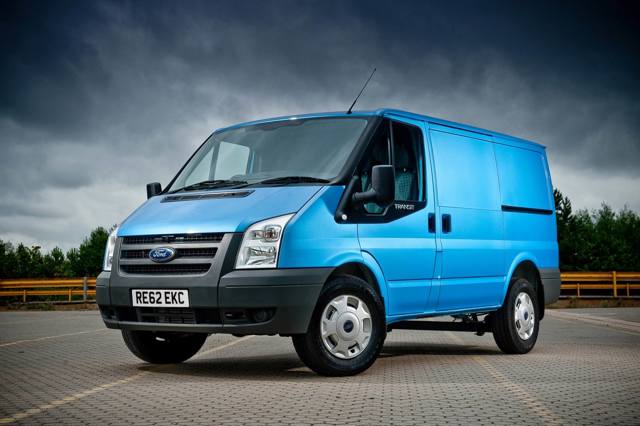
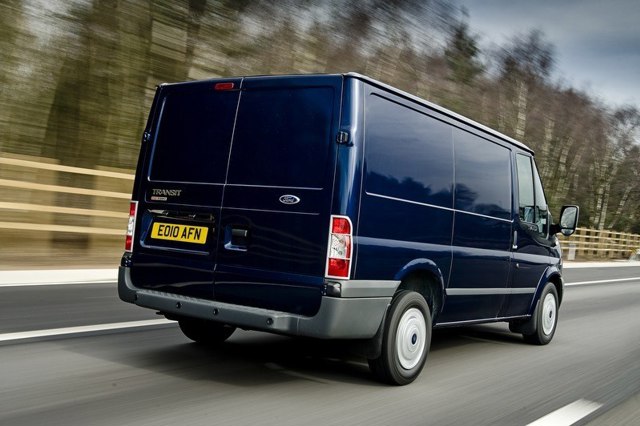

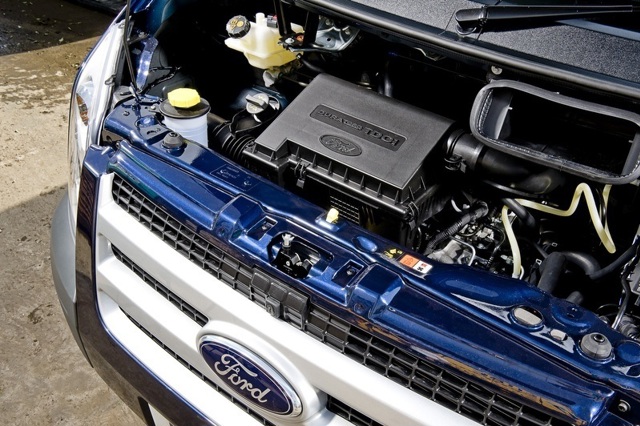
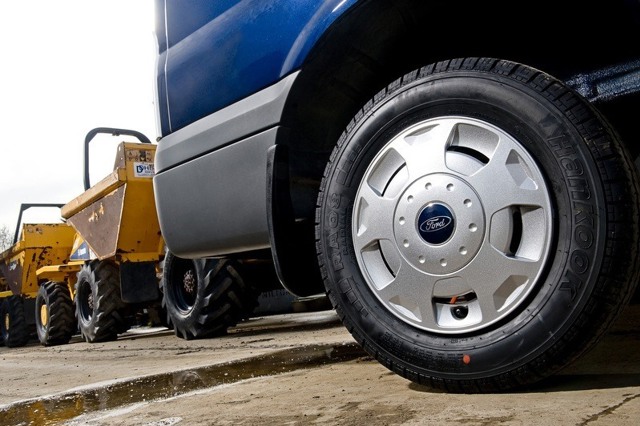
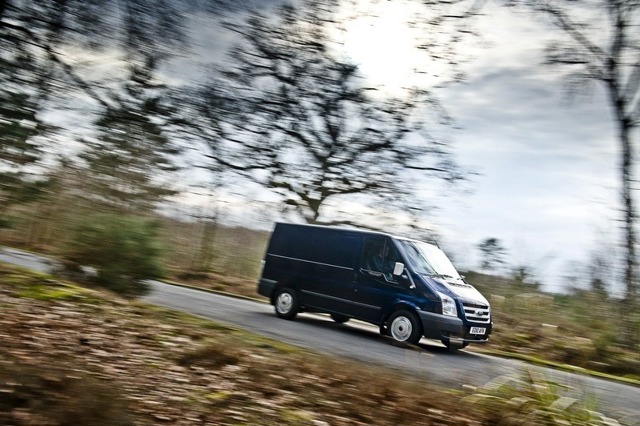
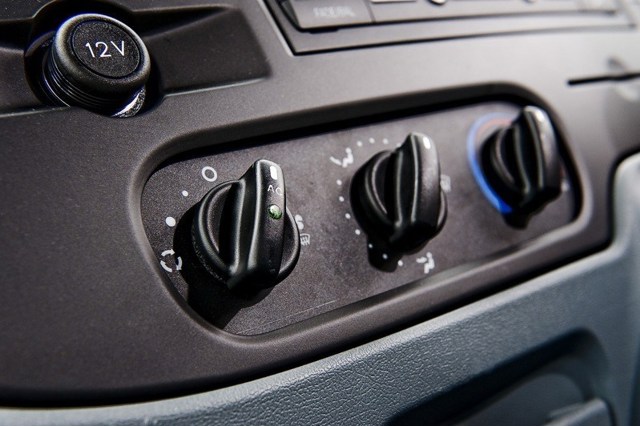
.jpg?width=640&height=426&rmode=crop)
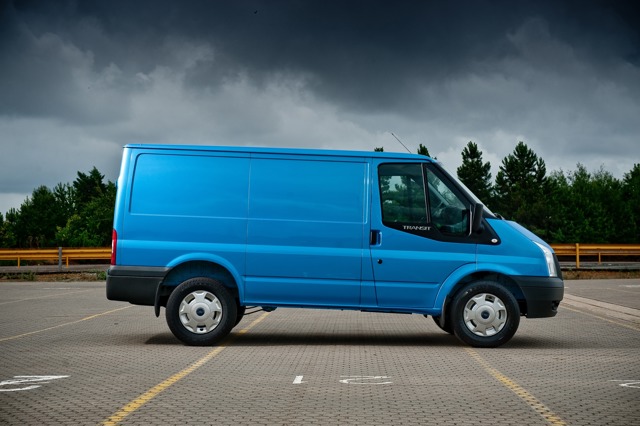

.jpg?width=640&height=426&rmode=crop)
.jpg?width=640&height=426&rmode=crop)
.jpg?width=640&height=426&rmode=crop)
.jpg?width=640&height=426&rmode=crop)


 The most popular van in the UK, superb in-cab refinement, tight turning circle and impressive handling, huge choice means there's something to suit all needs, ESP standard.
The most popular van in the UK, superb in-cab refinement, tight turning circle and impressive handling, huge choice means there's something to suit all needs, ESP standard.
 Load bay not as big as some rivals, curious that speed limiter can be switched off, some interior plastics feel flimsy.
Load bay not as big as some rivals, curious that speed limiter can be switched off, some interior plastics feel flimsy.


